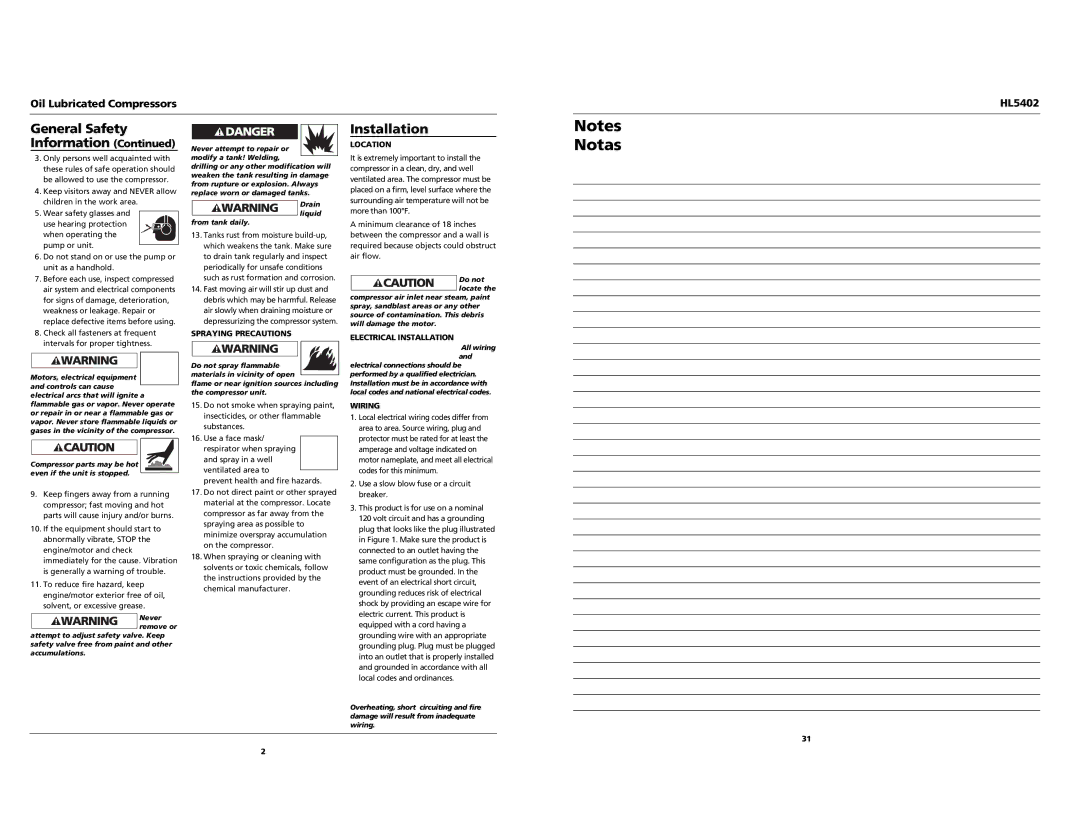
Oil Lubricated Compressors
HL5402
General Safety
Information (Continued)
3.Only persons well acquainted with these rules of safe operation should be allowed to use the compressor.
4.Keep visitors away and NEVER allow children in the work area.
5.Wear safety glasses and
use hearing protection when operating the pump or unit.
6.Do not stand on or use the pump or unit as a handhold.
7.Before each use, inspect compressed air system and electrical components for signs of damage, deterioration, weakness or leakage. Repair or replace defective items before using.
8.Check all fasteners at frequent intervals for proper tightness.
Motors, electrical equipment and controls can cause electrical arcs that will ignite a flammable gas or vapor. Never operate or repair in or near a flammable gas or vapor. Never store flammable liquids or gases in the vicinity of the compressor.
Compressor parts may be hot even if the unit is stopped.
9.Keep fingers away from a running compressor; fast moving and hot parts will cause injury and/or burns.
10.If the equipment should start to abnormally vibrate, STOP the engine/motor and check immediately for the cause. Vibration is generally a warning of trouble.
11.To reduce fire hazard, keep engine/motor exterior free of oil, solvent, or excessive grease.
Never remove or
attempt to adjust safety valve. Keep safety valve free from paint and other accumulations.
Never attempt to repair or modify a tank! Welding,
drilling or any other modification will weaken the tank resulting in damage from rupture or explosion. Always replace worn or damaged tanks.
Drain liquid
from tank daily.
13.Tanks rust from moisture
14.Fast moving air will stir up dust and debris which may be harmful. Release air slowly when draining moisture or depressurizing the compressor system.
SPRAYING PRECAUTIONS
Do not spray flammable materials in vicinity of open
flame or near ignition sources including the compressor unit.
15.Do not smoke when spraying paint, insecticides, or other flammable substances.
16.Use a face mask/ respirator when spraying
and spray in a well ![]()
![]() ventilated area to
ventilated area to ![]() prevent health and fire hazards.
prevent health and fire hazards.
17.Do not direct paint or other sprayed material at the compressor. Locate compressor as far away from the spraying area as possible to minimize overspray accumulation on the compressor.
18.When spraying or cleaning with solvents or toxic chemicals, follow the instructions provided by the chemical manufacturer.
Installation
LOCATION
It is extremely important to install the compressor in a clean, dry, and well ventilated area. The compressor must be placed on a firm, level surface where the surrounding air temperature will not be more than 100°F.
A minimum clearance of 18 inches between the compressor and a wall is required because objects could obstruct air flow.
Do not locate the
compressor air inlet near steam, paint spray, sandblast areas or any other source of contamination. This debris will damage the motor.
ELECTRICAL INSTALLATION
All wiring and
electrical connections should be performed by a qualified electrician. Installation must be in accordance with local codes and national electrical codes.
WIRING
1.Local electrical wiring codes differ from area to area. Source wiring, plug and protector must be rated for at least the amperage and voltage indicated on motor nameplate, and meet all electrical codes for this minimum.
2.Use a slow blow fuse or a circuit breaker.
3.This product is for use on a nominal 120 volt circuit and has a grounding plug that looks like the plug illustrated in Figure 1. Make sure the product is connected to an outlet having the same configuration as the plug. This product must be grounded. In the event of an electrical short circuit, grounding reduces risk of electrical shock by providing an escape wire for electric current. This product is equipped with a cord having a grounding wire with an appropriate grounding plug. Plug must be plugged into an outlet that is properly installed and grounded in accordance with all local codes and ordinances.
Overheating, short circuiting and fire damage will result from inadequate wiring.
Notes
Notas
31
2
